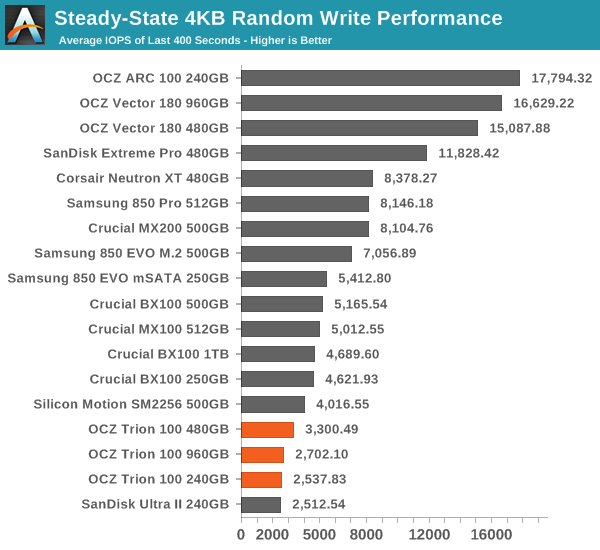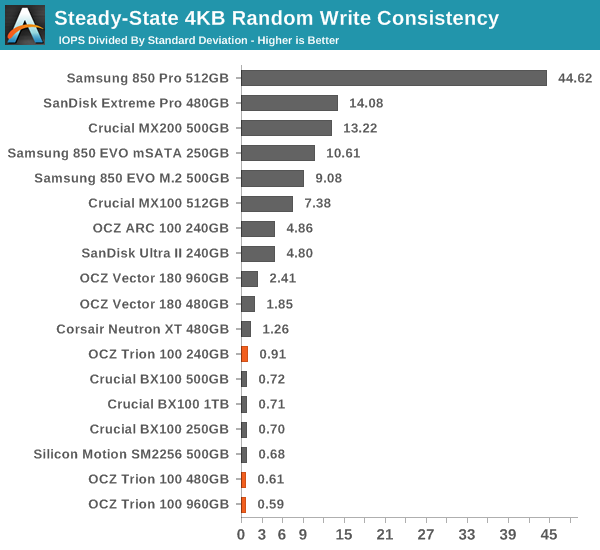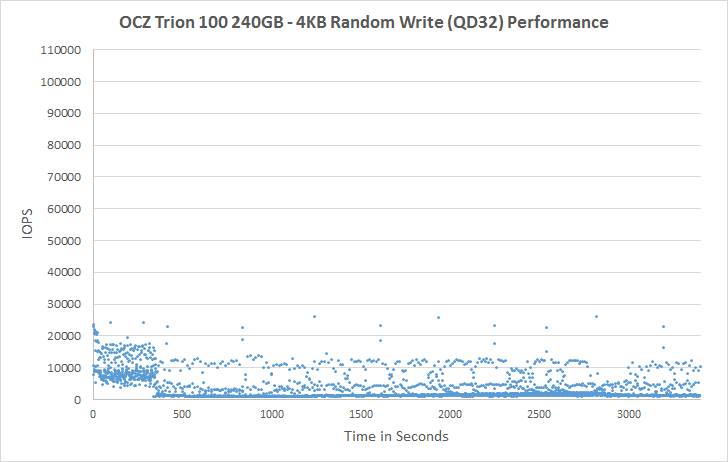OCZ Trion 100 (240GB, 480GB & 960GB) SSD Review: Bringing Toshiba to the Retail
by Kristian Vättö on July 9, 2015 12:01 PM ESTPerformance Consistency
We've been looking at performance consistency since the Intel SSD DC S3700 review in late 2012 and it has become one of the cornerstones of our SSD reviews. Back in the days many SSD vendors were only focusing on high peak performance, which unfortunately came at the cost of sustained performance. In other words, the drives would push high IOPS in certain synthetic scenarios to provide nice marketing numbers, but as soon as you pushed the drive for more than a few minutes you could easily run into hiccups caused by poor performance consistency.
Once we started exploring IO consistency, nearly all SSD manufacturers made a move to improve consistency and for the 2015 suite, I haven't made any significant changes to the methodology we use to test IO consistency. The biggest change is the move from VDBench to Iometer 1.1.0 as the benchmarking software and I've also extended the test from 2000 seconds to a full hour to ensure that all drives hit steady-state during the test.
For better readability, I now provide bar graphs with the first one being an average IOPS of the last 400 seconds and the second graph displaying the standard deviation during the same period. Average IOPS provides a quick look into overall performance, but it can easily hide bad consistency, so looking at standard deviation is necessary for a complete look into consistency.
I'm still providing the same scatter graphs too, of course. However, I decided to dump the logarithmic graphs and go linear-only since logarithmic graphs aren't as accurate and can be hard to interpret for those who aren't familiar with them. I provide two graphs: one that includes the whole duration of the test and another that focuses on the last 400 seconds of the test to get a better scope into steady-state performance.

TLC SSDs in general don't perform well under sustained random workloads and the Trion 100 is no exception. It seems that with TLC SSDs we have to accept a drop from 5K to 2-3K IOPS, which is still fine for basic client workloads since most SSDs from 3-4 years ago couldn't even match that.

The consistency isn't great either, but it's not particularly poor either when compared agains Silicon Motion drives.
 |
|||||||||
| Default | |||||||||
| 25% Over-Provisioning | |||||||||
Looking at the performance over time, we can see that the baseline performance hovers at about 1,000 IOPS with frequent peaks occuring at 5K to 10K IOPS. That's actually very similar to the Neutron XT's (Phison S10) graph because the baseline is also 1,000 IOPS, although the peaks are higher and more frequent, but it further reassures that the underlying firmware architecture is similar. Increasing over-provisioning doesn't increase the baseline performance, but it does make peak performance moments more frequent and higher (from 10K IOPS to 25K IOPS).
 |
|||||||||
| Default | |||||||||
| 25% Over-Provisioning | |||||||||










65 Comments
View All Comments
Samus - Thursday, July 9, 2015 - link
That isn't neccessarily true. Barefoot 3 firmware has been excellent from the beginning. Performance is good and reliability in my experience has been excellent.As far as OCZ drives go (this Toshiba drive included) Barefoot 3 drives are the only models to consider. We all know about OCZ's Sandforce firmware reliability and the Indilinx Everest has worse performance than the Marvell-based equivalent.
I still find it hard to consider drives other than Crucial MX100's and even older M500's because they are so reliable and inexpensive.
I just don't trust Samsung TLC drives, though, although quite hypocritically I am running the 850 EVO M.2 (500GB) in my laptop right now, which replaced a Crucial M550 (256GB) because Crucial's only M.2 single-sided drives in 512GB capacity are the MX200 which leaves a lot to be desired performance and power-wise, compared to the 850 EVO.
I just hope performance doesn't fall like a rock like the 840 EVO's did.
theuglyman0war - Friday, July 10, 2015 - link
hasn't it been long enough now to discern whether or not the 850 TLC suffers the same problems as the 840's? Was really hoping for a definitive follow up article by now. Or at least a community consensus. ( though I suppose it is rather cowardly to ask " did u guys blow yer money" as a research strategy :) )IlllI - Thursday, July 9, 2015 - link
I wonder when toshiba bought them out, if they were aware of the stigma of how awful the ocz line/brand of ssds were, and most people 'in the know' avoided them.Gigaplex - Thursday, July 9, 2015 - link
The stigma of OCZ isn't the only confusing part. Toshiba built their own in house SSD, why did they need OCZ in the first place?Samus - Thursday, July 9, 2015 - link
Because toshiba drives are dog slow. They have lost a lot of OEMs because of their performance. Look at the original macbook's that randomly gave customers toshiba or Samsung drives...take a guess which ones were substantially better? OCZ has indilinx which was easily worth what toshiba paid.Gigaplex - Friday, July 10, 2015 - link
And yet Toshiba opted to rebrand a Toshiba drive as OCZ, rather than the other way around.JellyRoll - Thursday, July 9, 2015 - link
You know what is REALLY amazing? This has better endurance than the 2TB 850 Pro, which is only .04 DWPD. Part of that is due to its ten-year warranty, BUT if you normalize the warranty periods the 850 PRO (and its 2bit MLC 3D V-NAND) is still not competitive with the 2D planar TLC on the OCZ. Shocking indeed.melgross - Thursday, July 9, 2015 - link
Don't make the error of confabulating "endurance", which is really no more than a theoretical number, with reliability. Samsung g's drives have, for the most part, proved to be reliable whereas OCz's have not.In fact, a problem here is that Toshiba has had their own reliability problems.
These tests don't tell us anything about that, as Anandtech has been enamoured with OCZ going way back, despite all of their problems. I'm disappointed they're even bothering to talk about OCZ until their reliability in the field is proven after the purchase. Otherwise, it's just more wasted time and energy.
Samus - Thursday, July 9, 2015 - link
Samsung drives have proven to be reliable, in that they don't fail, but they have also proven to have what is being covered up as a technological manufacturing defect dating back to the TLC-based 840 EVO that literally destroys the performance of the drive. The chill factor is Samsung A) initially ignored the issue, GM-style B) failed to fix the issue twice over 9 months of firmware updates and C) is now back to ignoring the issue, GM-style.At least OCZ published routine firmware updates, honored their warranties, and provided competitive prices.
kpb321 - Thursday, July 9, 2015 - link
I think the big issue with the 850Pro is that the warranty and rating on the drive is more about targeting a specific market rather than the actual performance of the V-NAND. The drive should be capable of much higher endurance. MLC V-NAND should have a much much higher endurance than TLC as it is trying to store fewer bits per cell and is a step back in lithography size making the cells bigger. Maybe Samsung is using some really low quality V-NAND in the 850 pro but I think it is really about "targeting" the drive at the consumer market rather than the data center.